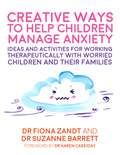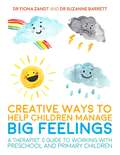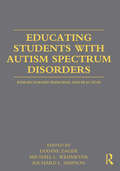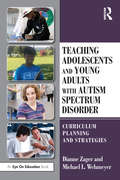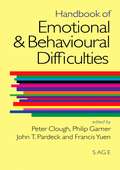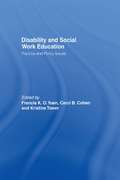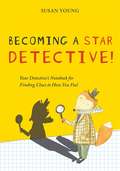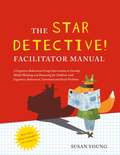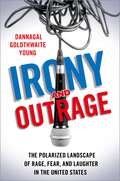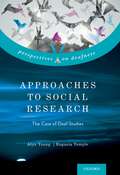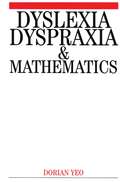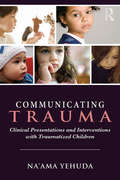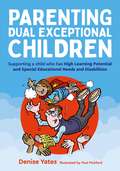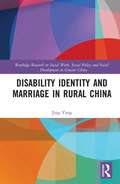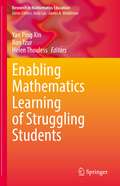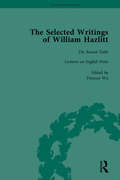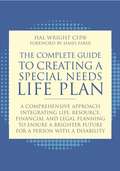- Table View
- List View
Creative Ways to Help Children Manage Anxiety: Ideas and Activities for Working Therapeutically with Worried Children and Their Families
by Fiona Zandt Suzanne BarrettThis book sets out therapeutic activities to help children aged 4-12 years and their families to better understand and manage anxiety. It explains how to work with anxious children, providing a framework for assessment and therapy that draws on CBT, ACT and narrative therapy approaches. Lots of practical tips for therapists are included and important developmental considerations are discussed, including adapting therapy for children with developmental difficulties, and working with families and schools.Over 50 playful therapeutic activities are included, which have been developed through the authors' extensive work with children, giving children an arsenal of coping strategies. They focus on key areas such as understanding anxiety, managing anxious thoughts, and building resilience and use readily available, inexpensive materials and downloadable templates which are provided in the book. This is the perfect tool for therapists looking for playful and purposeful ways to work with children with anxiety.
Creative Ways to Help Children Manage BIG Feelings: A Therapist's Guide to Working with Preschool and Primary Children (PDF)
by Dr Fiona Zandt Dr Lesley Bretherton Dr Suzanne BarrettTo be able to effectively offer therapy to children, complex therapeutic concepts need to be presented in an appropriate and engaging manner. This practical guide provides clinicians with a way in which to do so, with numerous games and imaginative activities to help children aged 4-12 to express and understand their feelings. Part I provides a comprehensive guide to working therapeutically with children and families, while Part II outlines 47 creative therapeutic activities. Each activity is presented with clear instructions using inexpensive and readily available resources and the objective and rationale of each activity is given, making it easily applicable. Activities range from using an easy to make volcano to help children better understand anger, to using a ball of string to illustrate how one person's feelings affect the whole family. This book is an invaluable resource for newly qualified clinicians, and also a treasure trove of creative ideas for experienced therapists.
Educating Students with Autism Spectrum Disorders: Research-Based Principles and Practices
by Dianne Zager Michael L. Wehmeyer Richard L. SimpsonSimilar to a handbook in its comprehensive description of the theory and research supporting current practices in the treatment of autism spectrum disorders, this interdisciplinary text shows how the existing knowledge base can be used to explore promising new possibilities related to the field’s many unanswered questions. Key features include the following: Comprehensive – This is the first book to consider the history and current state of autism as a field in transition, to cover its varied approaches and philosophies, and to describe the interventions used throughout the developmental cycle. Cross Disciplinary – Serving students with autism necessitates communication and collaboration among professionals from several disciplines as well as family members. The editors have, therefore, brought together divergent perspectives, theories and philosophies in order to demonstrate that scientific evidence, rather than educational orientation, must determine which practices should be selected for use in particular situations. Research Based – Whereas many existing texts advocate a particular type of treatment, this one recognizes that interventions must be selected and evaluated based on the scientific evidence of their effectiveness. Integrated Methodology –Chapter authors consider findings from studies that employed single-subject designs, experimental large-scale studies, and qualitative methodology. The inter-relatedness of therapies and disciplines will be highlighted throughout. Expertise – The volume editors are all highly visible researchers in autism and developmental disabilities. Likewise, each chapter is directed by a senior, highly accomplished author who is nationally recognized for his/her work in the topic being addressed. This book is appropriate for practicing professionals in education and psychology and for speech/language therapists and other clinicians. It is also suitable as a graduate level text in these fields.
Educating Students with Autism Spectrum Disorders: Research-Based Principles and Practices
by Dianne Zager Michael L. Wehmeyer Richard L. SimpsonSimilar to a handbook in its comprehensive description of the theory and research supporting current practices in the treatment of autism spectrum disorders, this interdisciplinary text shows how the existing knowledge base can be used to explore promising new possibilities related to the field’s many unanswered questions. Key features include the following: Comprehensive – This is the first book to consider the history and current state of autism as a field in transition, to cover its varied approaches and philosophies, and to describe the interventions used throughout the developmental cycle. Cross Disciplinary – Serving students with autism necessitates communication and collaboration among professionals from several disciplines as well as family members. The editors have, therefore, brought together divergent perspectives, theories and philosophies in order to demonstrate that scientific evidence, rather than educational orientation, must determine which practices should be selected for use in particular situations. Research Based – Whereas many existing texts advocate a particular type of treatment, this one recognizes that interventions must be selected and evaluated based on the scientific evidence of their effectiveness. Integrated Methodology –Chapter authors consider findings from studies that employed single-subject designs, experimental large-scale studies, and qualitative methodology. The inter-relatedness of therapies and disciplines will be highlighted throughout. Expertise – The volume editors are all highly visible researchers in autism and developmental disabilities. Likewise, each chapter is directed by a senior, highly accomplished author who is nationally recognized for his/her work in the topic being addressed. This book is appropriate for practicing professionals in education and psychology and for speech/language therapists and other clinicians. It is also suitable as a graduate level text in these fields.
Teaching Adolescents and Young Adults with Autism Spectrum Disorder: Curriculum Planning and Strategies
by Dianne Zager Michael L. WehmeyerTeaching Adolescents and Young Adults with Autism Spectrum Disorder supports teachers in preparing secondary students with autism spectrum disorder (ASD) to succeed in school, work and beyond. Focused on enabling students to successfully pursue further education and meaningful career paths, chapters incorporate person-centered, student-directed planning into instructional programming throughout the text. Featuring helpful vignettes to demonstrate concepts in action, curriculum areas address community living skills, academics, social communication and interaction, and career preparation. Grounded in current research and Universal Design for Learning practices, this guide is an essential resource for educators, therapists, and anyone seeking to create fluid, adaptable programs for students with autism spectrum disorders.
Teaching Adolescents and Young Adults with Autism Spectrum Disorder: Curriculum Planning and Strategies
by Dianne Zager Michael L. WehmeyerTeaching Adolescents and Young Adults with Autism Spectrum Disorder supports teachers in preparing secondary students with autism spectrum disorder (ASD) to succeed in school, work and beyond. Focused on enabling students to successfully pursue further education and meaningful career paths, chapters incorporate person-centered, student-directed planning into instructional programming throughout the text. Featuring helpful vignettes to demonstrate concepts in action, curriculum areas address community living skills, academics, social communication and interaction, and career preparation. Grounded in current research and Universal Design for Learning practices, this guide is an essential resource for educators, therapists, and anyone seeking to create fluid, adaptable programs for students with autism spectrum disorders.
Handbook of Emotional and Behavioural Difficulties (PDF)
by Professor Francis Yuen Professor John T Pardeck Professor Peter Clough Professor Philip Garner`At first glance I felt that this is a book that I should buy. On reading a selection of the chapters I realized that I must buy it. Each of the four sections has chapter that I know I will want to read and many others that I will read. It is a book that will provide student and authors in Higher Education and practitioners with much food for thought. It also emphasizes the desperate need to cut through much of the polemic that abounds in this field and to return to argument based on carefully conducted empirical work’ - Harry Daniels, Deputy Head of School and Director of Research, School of Education, University of Birmingham `Emotional and Behavioural Difficulties (EBD) in schools can be defined in many ways. For example, EBD can be seen as: a set of problems that reside mainly within the individual student; as the result of interactions between social and psychological sub-systems, or as the product of professional discourses that create and maintain the very problems that they purport to identify and solve. Clough and Garner's Handbook of Emotional and Behavioural Difficulties sheds light on all of these perspectives and reveals the enormous complexity and diversity of what is termed "EBD". In doing this, the book reveals itself to be both a scholarly and practical resource that will be indispensable to anyone seeking insight and direction for understanding and responding to EBD in the 21st century. Readers looking for off the cuff 'tips for teachers' or simplistic solutions will not find what they want in this book. Rather, the Handbook of Emotional and Behavioural Difficulties will appeal to readers who want to hear from writers who have genuine insight into the multi-faceted world of EBD, who have worthwhile things to say about the range of possible solution to this area of difficulty, and, regardless of differences that might appear between their theoretical positions, share a sense of deep compassion for needs of students and educational professionals who experience EBD on day-to-day basis' - Professor Paul Cooper, The University of Leicester The behaviour of children in primary and secondary schools has been a consistent source of interest and controversy since the 19th century. Some commentators suggest that the phenomenon has a far more impressive historical pedigree. As education systems in First World democracies struggle to meet changing social, economic and educational conditions, one group of children has increasingly become the focus of attention. These are those who, for a variety of underpinning reasons, are either unable or unwilling to conform to the requirements of formal schooling. As a result they are identified as having Emotional and/or Behavioural Difficulties (EBDs) of one level of severity or another. Contemporary debate increasingly links causation with intervention, to form a holistic approach to problem prevention or remediation.
Disability and Social Work Education: Practice and Policy Issues
by Francis K. O. Yuen Carol B. Cohen Kristine TowerBridging the chasm between the disabled and a just and fair society takes skill, dedication, and a deep understanding of the issues. Disability and Social Work Education: Practice and Policy Issues presents leading social work experts providing insightful, effective strategies to address the current gaps in the system between social work and those individuals with disabilities. Diverse perspectives on all levels of social work practice are integrated with the basic tenets of social justice, accessibility to services, and human rights. Specific challenges and issues are addressed in work with disabled populations. Disability and Social Work Education: Practice and Policy Issues examines the social construction of disability that connotes inferiority and highlights practical strategies for change. This creative resource gives social work educators, students, and practitioners the opportunity to embrace diverse and creative ways for integrating a generalist social work model in their work with various size systems that are related to disability. Chapters include extensive references, appendixes, tables, and figures to clearly illustrate topics. Topics in Disability and Social Work Education: Practice and Policy Issues include: model curriculum on disabilities that incorporates diverse perspectives of social work practice with individuals who have physical, cognitive, and psychiatric disabilities protecting the legal rights of children and the Individuals with Disabilities Education Act (IDEA) empowering disabled individuals for civil rights to have access to community living the academic process of helping students who are disabled achieve their academic goals components of the Americans with Disabilities Act—and key decisions made by the Supreme Court strategies of intervention for macro change historical overview of family policy and practice as it relates to children and adolescents who are disabled the biopsychosocial framework as an assessment tool to develop interventions the use of the therapeutic relationship and psychodynamic and ecological approaches to social work practices helping clients with disabilities develop adaptive religious and spiritual beliefs disability protests and movements and their implications on social work practice the Capacity Approach and the International Classification of Functioning, Disability and Health as social work tools basic guidelines for undertaking research about and with people who have disabilities Disability and Social Work Education: Practice and Policy Issues is a valuable, unique resource for social work educators, students, and practitioners.
Disability and Social Work Education: Practice and Policy Issues
by Francis K. O. Yuen Carol B. Cohen Kristine TowerBridging the chasm between the disabled and a just and fair society takes skill, dedication, and a deep understanding of the issues. Disability and Social Work Education: Practice and Policy Issues presents leading social work experts providing insightful, effective strategies to address the current gaps in the system between social work and those individuals with disabilities. Diverse perspectives on all levels of social work practice are integrated with the basic tenets of social justice, accessibility to services, and human rights. Specific challenges and issues are addressed in work with disabled populations. Disability and Social Work Education: Practice and Policy Issues examines the social construction of disability that connotes inferiority and highlights practical strategies for change. This creative resource gives social work educators, students, and practitioners the opportunity to embrace diverse and creative ways for integrating a generalist social work model in their work with various size systems that are related to disability. Chapters include extensive references, appendixes, tables, and figures to clearly illustrate topics. Topics in Disability and Social Work Education: Practice and Policy Issues include: model curriculum on disabilities that incorporates diverse perspectives of social work practice with individuals who have physical, cognitive, and psychiatric disabilities protecting the legal rights of children and the Individuals with Disabilities Education Act (IDEA) empowering disabled individuals for civil rights to have access to community living the academic process of helping students who are disabled achieve their academic goals components of the Americans with Disabilities Act—and key decisions made by the Supreme Court strategies of intervention for macro change historical overview of family policy and practice as it relates to children and adolescents who are disabled the biopsychosocial framework as an assessment tool to develop interventions the use of the therapeutic relationship and psychodynamic and ecological approaches to social work practices helping clients with disabilities develop adaptive religious and spiritual beliefs disability protests and movements and their implications on social work practice the Capacity Approach and the International Classification of Functioning, Disability and Health as social work tools basic guidelines for undertaking research about and with people who have disabilities Disability and Social Work Education: Practice and Policy Issues is a valuable, unique resource for social work educators, students, and practitioners.
Becoming a STAR Detective!: Your Detective's Notebook for Finding Clues to How You Feel (PDF)
by Professor Susan YoungThe STAR Program is designed to teach children and those involved in their care psychological techniques to improve self-control and prosocial competence. The program employs cognitive-behavioral therapy (CBT) principles and uses a child-centered approach to teach attention skills, emotional control, problem-solving, and interpersonal skills to children aged 8-12 who have cognitive, behavioral, social or emotional difficulties. This workbook is given to the child upon joining the program with sections for each group session and individual exercises to be completed between meetings. With games, helpful tips, activities and extra space to personalize the workbook with notes and drawings, this is an essential companion for children participating in the STAR Program.
The STAR Detective Facilitator Manual: A Cognitive Behavioral Group Intervention to Develop Skilled Thinking and Reasoning for Children with Cognitive, Behavioral, Emotional and Social Problems
by Professor Susan YoungThe STAR Program is designed to teach children and those involved in their care psychological techniques to improve self-control and prosocial competence. The program employs cognitive-behavioral therapy (CBT) principles and uses a child-centered approach to teach attention skills, emotional control, problem-solving, and interpersonal skills to children aged 8-12 who have cognitive, behavioral, social or emotional difficulties. This manual includes designated group sessions to be delivered by healthcare practitioners alongside individual coaching sessions to be provided by a family member or individual carer between each group meeting. Extra materials include PowerPoint presentations, and a Thinking Tools resource, which are available to download from the JKP website.
The STAR Detective Facilitator Manual: A Cognitive Behavioral Group Intervention to Develop Skilled Thinking and Reasoning for Children with Cognitive, Behavioral, Emotional and Social Problems (PDF)
by Professor Susan YoungThe STAR Program is designed to teach children and those involved in their care psychological techniques to improve self-control and prosocial competence. The program employs cognitive-behavioral therapy (CBT) principles and uses a child-centered approach to teach attention skills, emotional control, problem-solving, and interpersonal skills to children aged 8-12 who have cognitive, behavioral, social or emotional difficulties. This manual includes designated group sessions to be delivered by healthcare practitioners alongside individual coaching sessions to be provided by a family member or individual carer between each group meeting. Extra materials include PowerPoint presentations, and a Thinking Tools resource, which are available to download from the JKP website.
Irony and Outrage: The Polarized Landscape of Rage, Fear, and Laughter in the United States
by Dannagal Goldthwaite YoungFor almost a decade, journalists and pundits have been asking why we don't see successful examples of political satire from conservatives or of opinion talk radio from liberals. This book turns that question on its head to argue that opinion talk is the political satire of the right and political satire is the opinion programming of the left. They look and feel like two different animals because their audiences are literally, two different animals. In Irony and Outrage, political and media psychologist Dannagal Goldthwaite Young explores the aesthetics, underlying logics, and histories of these two seemingly distinct genres, making the case that they should be thought of as the logical extensions of the psychology of the left and right, respectively. One genre is guided by ambiguity, play, deliberation, and openness, while the other is guided by certainty, vigilance, instinct, and boundaries. While the audiences for Sean Hannity and John Oliver come from opposing political ideologies, both are high in political interest, knowledge, and engagement, and both lack faith in many of our core democratic institutions. Young argues that the roles that these two genres play for their viewers are strikingly similar: galvanizing the opinion of the left or the right, mobilizing citizens around certain causes, and expressing a frustration with traditional news coverage while offering alternative sources of information and meaning. One key way in which they differ, however, concludes Young, is in their capacity to be exploited by special interests and political elites. Drawing on decades of research on political and media psychology and media effects, as well as historical accounts and interviews with comedians and comedy writers, Young unpacks satire's liberal "bias" and juxtaposes it with that of outrage's conservative "bias." She details how traits like tolerance for ambiguity and the motivation to engage with complex ideas shape our preferences for art, music, and literature; and how those same traits correlate with political ideology. In turn, she illustrates how these traits help explain why liberals and conservatives vary in the genres of political information they prefer to create and consume.
Dyslexia, Dyspraxia and Mathematics
by Dorian YeoWritten by a teacher with many years' experience of teaching mathematics to primary school dyslexic and dyspraxic children with a wide range of abilities, this book is designed to be a practical teaching guide. It offers detailed guidance and specific teaching suggestions to all specialist teachers, support teachers, classroom teachers and parents who either directly teach mathematics to dyslexic and dyspraxic children or who support the mathematics teaching programmes of dyslexic or dyspraxic children. Although the book has grown out of teaching experience it is also informed by widely acknowledged contemporary and international research, which explores the cognitive aspects of learning mathematics and tries to understand why it is that some children fail to learn mathematics. Many of the teaching principles described in the text have specific and quite far-reaching implications. The theoretical arguments should therefore also be of interest to special needs co-ordinators, heads of maths departments, head teachers or other professionals who are responsible for designing or modifying the maths learning programmes of children with special learning and maths difficulties. In more general terms, the book hopes to contribute to the broad discussion of the cognitive features and educational needs of dyslexic and dyspraxic children.
Communicating Trauma: Clinical Presentations and Interventions with Traumatized Children
by Na'ama YehudaCommunicating Trauma explores the various aspects of language and communication and how their development can be affected by childhood trauma and overwhelm. Multiple case-study vignettes describe how different kinds of childhood trauma can manifest in children's ability to relate, attend, learn, and communicate. These examples offer ways to understand, respond, and support children who are communicating overwhelm. In this book, psychotherapists, speech-language pathologists, social workers, educators, occupational and physical therapists, medical personnel, foster parents, adoption agencies, and other child professionals and caregivers will find information and practical direction for improving connection and behavior, reducing miscommunication, and giving a voice to those who are often our most challenging children.
Communicating Trauma: Clinical Presentations and Interventions with Traumatized Children
by Na'ama YehudaCommunicating Trauma explores the various aspects of language and communication and how their development can be affected by childhood trauma and overwhelm. Multiple case-study vignettes describe how different kinds of childhood trauma can manifest in children's ability to relate, attend, learn, and communicate. These examples offer ways to understand, respond, and support children who are communicating overwhelm. In this book, psychotherapists, speech-language pathologists, social workers, educators, occupational and physical therapists, medical personnel, foster parents, adoption agencies, and other child professionals and caregivers will find information and practical direction for improving connection and behavior, reducing miscommunication, and giving a voice to those who are often our most challenging children.
Parenting Dual Exceptional Children: Supporting a Child who Has High Learning Potential and Special Educational Needs and Disabilities
by Denise YatesThis is the first comprehensive guide for parents of children with Dual and Multiple Exceptionality (DME, sometimes called Twice Exceptionality or 2E). Children with high learning potential may also have conditions such as ASD, ADHD, dyslexia and dyspraxia, having 'flashes of brilliance' in some areas whilst needing additional support in others. As a result, their abilities may not always be recognised in an educational setting.This book takes a strengths-based approach towards helping parents recognise and focus on their child's areas of potential to support them towards better attainment and self-esteem, and build on these abilities while also identifying and addressing areas of difficulty. It provides an understanding of the mixed learning profile of DME children, explaining why they excel in some areas but not others, as well as guidance for parents on working positively with schools and providing their child with the support they need.With stories, quotes from parents and examples throughout, this is an essential guide to helping DME children achieve their full untapped potential.
Parenting Dual Exceptional Children: Supporting a Child who Has High Learning Potential and Special Educational Needs and Disabilities
by Denise YatesThis is the first comprehensive guide for parents of children with Dual and Multiple Exceptionality (DME, sometimes called Twice Exceptionality or 2E). Children with high learning potential may also have conditions such as ASD, ADHD, dyslexia and dyspraxia, having 'flashes of brilliance' in some areas whilst needing additional support in others. As a result, their abilities may not always be recognised in an educational setting.This book takes a strengths-based approach towards helping parents recognise and focus on their child's areas of potential to support them towards better attainment and self-esteem, and build on these abilities while also identifying and addressing areas of difficulty. It provides an understanding of the mixed learning profile of DME children, explaining why they excel in some areas but not others, as well as guidance for parents on working positively with schools and providing their child with the support they need.With stories, quotes from parents and examples throughout, this is an essential guide to helping DME children achieve their full untapped potential.
Disability Identity and Marriage in Rural China (Routledge Research on Social Work, Social Policy and Social Development in Greater China)
by Jing YangBased on data collected through in-depth fieldwork observation and interviews in Bai Township, this book examines how women with disabilities in rural Southwest China compensate for their disability identity through marriage. As the first book to theorize the married life of rural-based women with different types of disabilities, it provides a more holistic picture of their marital life by tracing the marriage process from mate selection to wedding ceremony, reproduction and role performance. It also generates a substantive theory grounded in the real experiences of women living with disabilities with Jing Yang arguing that these women are not passive victims in the marital process, but active agents who endeavour to minimize the risk of abuse and maximize security and satisfaction in their marriage. By examining the effects of fertility, patriarchy and village society on women with disability, this book will be of huge interest to students and scholars of many disciplines, including disability studies, sociology, social work, women's studies and Chinese culture and society.
Disability Identity and Marriage in Rural China (Routledge Research on Social Work, Social Policy and Social Development in Greater China)
by Jing YangBased on data collected through in-depth fieldwork observation and interviews in Bai Township, this book examines how women with disabilities in rural Southwest China compensate for their disability identity through marriage. As the first book to theorize the married life of rural-based women with different types of disabilities, it provides a more holistic picture of their marital life by tracing the marriage process from mate selection to wedding ceremony, reproduction and role performance. It also generates a substantive theory grounded in the real experiences of women living with disabilities with Jing Yang arguing that these women are not passive victims in the marital process, but active agents who endeavour to minimize the risk of abuse and maximize security and satisfaction in their marriage. By examining the effects of fertility, patriarchy and village society on women with disability, this book will be of huge interest to students and scholars of many disciplines, including disability studies, sociology, social work, women's studies and Chinese culture and society.
Enabling Mathematics Learning of Struggling Students (Research in Mathematics Education)
by Yan Ping Xin Ron Tzur Helen ThoulessThis book provides prospective and practicing teachers with research insights into the mathematical difficulties of students with learning disabilities and classroom practices that address these difficulties. This linkage between research and practice celebrates teachers as learners of their own students’ mathematical thinking, thus contributing an alternative view of mathematical progression in which students are taught conceptually. The research-based volume presents a unique collaboration among researchers in special education, psychology, and mathematics education from around the world. It reflects an ongoing work by members of the International Group for the Psychology of Mathematics Education (PME) and the North American Chapter of the PME Working Groups. The authors of chapters in this book, who have been collaborating extensively over the past 7 years, are from Australia, Canada, the United Kingdom, and the United States.
The Selected Writings of William Hazlitt Vol 2
by Duncan Wu Tom Paulin David Bromwich Stanley Jones Roy ParkWilliam Hazlitt is viewed by many as one of the most distinguished of the non-fiction prose writers to emerge from the Romantic period. This nine-volume edition collects all his major works in complete form.
The Selected Writings of William Hazlitt Vol 2
by Duncan Wu Tom Paulin David Bromwich Stanley Jones Roy ParkWilliam Hazlitt is viewed by many as one of the most distinguished of the non-fiction prose writers to emerge from the Romantic period. This nine-volume edition collects all his major works in complete form.
The Complete Guide to Creating a Special Needs Life Plan: A Comprehensive Approach Integrating Life, Resource, Financial, and Legal Planning to Ensure a Brighter Future for a Person with a Disability (PDF)
by Hal Wright James FaberThe purpose of special needs planning is to create the best possible life for an adult with a disability. This book provides comprehensive guidance on creating a life plan to transition a special needs child to independence or to ensure they are well cared for in the future. Beginning with a vision of a meaningful life for the child, Hal Wright explains how to form a practical plan to reach these goals, how to mentor personal empowerment and task skills, and how to create circles of support to sustain a life plan. He next looks at employment and residential options, and government programs available in the United States. Finally he talks the reader through important financial and legal considerations, including how to fund and manage a special needs trust. This book will be essential reading for all parents or guardians of a child with a cognitive, mental or physical impairment. It will also be of interest to attorneys, financial planners, insurance agents, trust officers and other professionals looking to better serve the special needs community.
